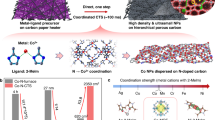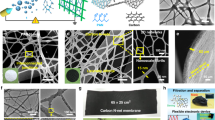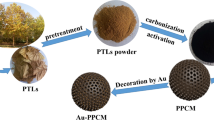Abstract
Nanostructured carbon materials are potentially of great technological interest for the development of electronic1,2, catalytic3,4 and hydrogen-storage systems5,6. Here we describe a general strategy for the synthesis of highly ordered, rigid arrays of nanoporous carbon having uniform but tunable diameters (typically 6 nanometres inside and 9 nanometres outside). These structures are formed by using ordered mesoporous silicas as templates, the removal of which leaves a partially ordered graphitic framework. The resulting material supports a high dispersion of platinum nanoparticles, exceeding that of other common microporous carbon materials (such as carbon black, charcoal and activated carbon fibres). The platinum cluster diameter can be controlled to below 3 nanometres, and the high dispersion of these metal clusters gives rise to promising electrocatalytic activity for oxygen reduction, which could prove to be practically relevant for fuel-cell technologies. These nanomaterials can also be prepared in the form of free-standing films by using ordered silica films as the templates.
This is a preview of subscription content, access via your institution
Access options
Subscribe to this journal
Receive 51 print issues and online access
$199.00 per year
only $3.90 per issue
Buy this article
- Purchase on Springer Link
- Instant access to full article PDF
Prices may be subject to local taxes which are calculated during checkout




Similar content being viewed by others
References
Fan, S. et al. Self-oriented regular arrays of carbon nanotubes and their field emission properties. Science 283, 512–514 (1999).
Rueckes, T. et al. Carbon nanotube-based nonvolatile random access memory for molecular computing. Science 289, 94–97 (2000).
Planeix, J. M. et al. Applications of carbon nanotubes as supports in heterogeneous catalysis. J. Am. Chem. Soc. 116, 7935–7936 (1994).
Rodriguez, N. M., Chambers, A. & Baker, R. T. K. Catalytic engineering of carbon nanostructures. Langmuir 11, 3862–3866 (1995).
Dillon, A. C. et al. Storage of hydrogen in single-walled carbon nanotubes. Nature 386, 377–379 (1997).
Lin, J. Hydrogen storage in nanotubes. Science 287, 1929–1929 (2000).
Dresselhaus, M. S., Dresselhaus, G. & Eklund, P. C. Science of Fullerenes and Carbon Nanotubes (Academic, San Diego, 1996).
Kyotani, T., Tsai, L.-F. & Tomita, A. Formation of ultrafine carbon tubes by using an anodic aluminum oxide film as a template. Chem. Mater. 7, 1427–1428 (2000).
Thess, A. et al. Crystalline ropes of metallic carbon nanotubes. Science 273, 483–487 (1996).
Kruk, M., Jaroniec, M., Ko, C. H. & Ryoo, R. Characterization of the porous structure of SBA-15. Chem. Mater. 12, 1961–1968 (2000).
Lettow, J. S. et al. Hexagonal to mesocellular foam phase transition in polymer-templated mesoporous silicas. Langmuir 16, 8291–8295 (2000).
Ryoo, R., Jun, S., Kim, J. M. & Kim, M. J. Generalised route to the preparation of mesoporous metallosilicates via post-synthetic metal implantation. Chem. Commun. 2225–2226 (1997).
Jun, S. et al. Synthesis of new, nanoporous carbon with hexagonally ordered mesostructure. J. Am. Chem. Soc. 122, 10712–10713 (2000).
Ryoo, R., Joo, S. H. & Jun, S. Synthesis of highly ordered carbon molecular sieves via template-mediated structural transformation. J. Phys. Chem. B 103, 7743–7746 (1999).
Kruk, M., Jaroniec, M. & Sayari, A. Application of large pore MCM-41 molecular sieves to improve pore size analysis using nitrogen adsorption measurements. Langmuir 13, 6267–6273 (1997).
Kageyama, K., Tamazawa, J. & Aida, T. Extrusion polymerization: catalyzed synthesis of crystalline linear polyethylene nanofibers within a mesoporous silica. Science 285, 2113–2115 (1999).
Radovic, L. R. & Ridriguiz-Reinoso, F. in Chemistry and Physics of Carbon Vol. 25 (ed. Thrower, P. A.) 243–358 (Marcel-Dekker, New York, 1997).
Kinoshita, K. Carbon, Electrochemical and Physicochemical Properties (John Wiley & Sons, New York, 1988).
Ryoo, R. et al. Application of the xenon-adsorption method for the study of metal cluster formation and growth on Y zeolite. J. Am. Chem. Soc. 114, 76–82 (1992).
Kordesch, K. & Simader, G. Fuel Cells and Their Electrochemistry (VCH, Weinheim, 1996).
Peuckert, M., Yoneda, T., Dalla Betta, R. A. & Boudart, M. Oxygen reduction on small supported platinum particles. J. Electrochem. Soc. 133, 944–947 (1986).
Poirier, J. A. & Stoner, G. E. Microstructural effects on electrocatalytic oxygen reduction activity of nano-grained thin-film platinum in acid media. J. Electrochem. Soc. 141, 425–430 (1994).
Takasu, Y. et al. Size effects of platinum particles on the electroreduction of oxygen. Electrochim. Acta 41, 2595–2600 (1996).
Wasmus, S. & Kuver, A. Methanol oxidation and direct methanol fuel cells: a selective review. J. Electroanal. Chem. 461, 14–31 (1999).
Yang, P., Zhao, D., Chmelka, B. F. & Stucky, G. D. Triblock-copolymer-directed syntheses of large-pore mesospore silica fibers. Chem. Mater. 10, 2033–2036 (1998).
Huang, L. et al. Fabrication of ordered porous structures by self-assembly of zeolite nanocrystals. J. Am. Chem. Soc. 122, 3530–3531 (2000).
Doshi, D. A. et al. Optically, defined multifunctional patterning of photosensitive thin-film silica mesophases. Science 290, 107–111 (2000).
Fan, H. Y. et al. Rapid prototyping of patterned functional nanostructures. Nature 405, 56–60 (2000).
Cho, S. J., Ahn, W.-S., Hong, S. B. & Ryoo, R. Investigation of the platinum cluster size and location on zeolite KL with 129Xe NMR, XAFS, and xenon adsorption. J. Phys. Chem. 100, 4996–5003 (1996).
Acknowledgements
R.R. thanks M. Nomura for helpful discussions on EXAFS measurement. This work was supported in part by the Ministry of Science and Technology through the Creative Research Initiative Program (R.R.), by the School of Molecular Science through the Brain Korea 21 Project (R.R. and J.K.), by the Korea Science and Engineering Foundation through the MICROS Center at KAIST (J.K.), and by CREST, Japan Science and Technology Corporation (O.T.).
Author information
Authors and Affiliations
Corresponding author
Supplementary information

Figure 5
(JPG 11 KB)
Pore size distribution for carbon nanopipe determined by Barrett-Joyner-Halenda analysis of the N2 adsorption isotherm (calculated as described in ref. 15). Inset: N2 adsorption-desorption isotherms

Figure 6
(JPG 13.4 KB)
EXAFS data for Pt/carbon nanopipe. a, k3-weighted EXAFS oscillation [k3c (k)] for 2 wt% Pt/carbon nanopipe in wave vector (k) space. b, Fourier transform of the k3c (k) to distance (r)-space. Solid lines: experimental. Dashed lines: best curve fits obtained with Pt-Pt coordination number of 5.4, bond distance of 0.255 nm and Debye-Waller factor of 106 pm2, with the assumption of face-centered-cubic packing and spherical cluster geometry.

Figure 7
(JPG 3 KB)
Scanning electron microscopic image of carbon nanopipe sample in the form of freestanding thin film. The image was taken by a Philips 535M apparatus operating at 20 kV.
Rights and permissions
About this article
Cite this article
Joo, S., Choi, S., Oh, I. et al. Ordered nanoporous arrays of carbon supporting high dispersions of platinum nanoparticles. Nature 412, 169–172 (2001). https://doi.org/10.1038/35084046
Received:
Accepted:
Issue Date:
DOI: https://doi.org/10.1038/35084046
This article is cited by
-
Creating hierarchical pores in metal–organic frameworks via postsynthetic reactions
Nature Protocols (2023)
-
Recent progress in porous carbon-supported materials as efficient oxygen electrocatalysts for zinc-air batteries
Science China Materials (2023)
-
Post-synthetic electrostatic adsorption-assisted fabrication of efficient single-atom Fe-N-C oxygen reduction catalysts for Zn-air batteries
Science China Materials (2023)
-
Recent advances in properties and applications of nanoporous materials and porous carbons
Carbon Letters (2022)
-
Sulfur/Nitrogen Co-Doped Mesoporous Carbon for High-Performance Lithium-Ion Battery Anodes
Journal of Electronic Materials (2022)
Comments
By submitting a comment you agree to abide by our Terms and Community Guidelines. If you find something abusive or that does not comply with our terms or guidelines please flag it as inappropriate.



